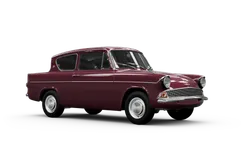

Ford Anglia Model: History, Features, and More
Discover the Ford Anglia's rich history, unique features, and specifications. Learn what makes this classic car a timeless icon in Portugal.
Ford Anglia
Mycarro AI
Feb 1, 2024
Introduction
The Ford Anglia is a classic British car model that was produced by Ford between 1939 and 1967. It gained popularity for its affordable price, compact size, and reliable performance. The Anglia was widely recognized for its distinctive design, featuring a sweeping roofline and iconic rear window.
History
The Ford Anglia was initially introduced as a two-door saloon and was marketed as Ford's compact family car. The first generation, known as the E04A, was introduced in 1939 and was powered by a 933cc side-valve engine. However, due to World War II, production of the Anglia was temporarily halted, with only a limited number of units being released.
After the war, Ford resumed production of the Anglia in 1945, and in 1948, the second-generation model, known as the E494A, was introduced. This updated version featured a slightly modified exterior design and an improved 1172cc engine. It quickly gained popularity and became one of the best-selling cars in the UK during the 1950s.
Design
The Ford Anglia's design was known for its unique features. One of the most recognizable aspects of its design was the large, backward-slanting rear window. This feature gave the driver excellent visibility and became an iconic trademark of the Anglia. The car also had a rounded body shape, with flowing lines that added to its visual appeal.
Inside, the Anglia offered a simple yet functional dashboard layout. The seats were comfortable and provided ample legroom for both the driver and passengers. Despite its compact size, the Anglia had a surprising amount of space for its occupants and offered a practical and comfortable driving experience.
Performance
The Ford Anglia was equipped with reliable engines that delivered decent performance for its time. The early models featured a 933cc side-valve engine, producing around 23 horsepower. However, with the introduction of the second-generation model in 1948, the engine was upgraded to a 1172cc overhead valve unit, which increased power output to 36 horsepower.
Although the Anglia was not a high-performance car, it offered adequate power for everyday driving and was known for its fuel efficiency. The car had a top speed of around 70 mph and was capable of reaching 0-60 mph in just under 40 seconds. The Anglia's simple mechanics and lightweight construction made it easy to maneuver, especially in urban environments.
Legacy
The Ford Anglia left a lasting legacy in the automotive industry. Its timeless design and affordable price made it a popular choice among buyers, and it became a symbol of the British motoring culture of the mid-20th century. The car had a significant impact on Ford's success, establishing the company's reputation for producing reliable and practical vehicles.
Today, the Ford Anglia has become a sought-after classic car among collectors and enthusiasts. Its distinctive design and nostalgic appeal continue to captivate the hearts of car enthusiasts worldwide. Restored examples of the Anglia can be seen at classic car shows and are cherished by those who appreciate the rich history and iconic status of this beloved car model.
Conclusion
The Ford Anglia holds a special place in automotive history, thanks to its unique design, reliable performance, and affordability. It remains a beloved classic car model, cherished by car enthusiasts and collectors alike. The distinctive features, such as the backward-slanting rear window, make it instantly recognizable and continue to make a lasting impression on anyone who sees it. The Ford Anglia is undoubtedly a significant part of British automotive heritage and will always be remembered as a true icon of its time.